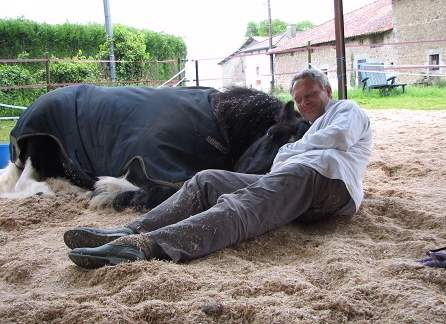We tend to focus on the feet when a horse has laminitis, but we need to remember that the whole body will be uncomfortable. We need to do everything we can to support the feet, remove shearing forces on the laminae and give the horse a large weight bearing surface at the back of the foot, relieve the pain (with ice, NSAIDs - on vet's advice), encourage the horse to lie down and rest with a deep bed that's kept immaculately clean, eliminate stress and ease discomfort by ensuring companions are kept close but far enough away that they can't make the laminitic horse move, ensuring it is quiet enough that the horse can rest comfortably, keeping food and water close by and perhaps off the floor if the horse is standing to eat so that there's less pressure on the front feet. Many horses with laminitis will appreciate gentle body massage or grooming - TTouch, Equine Touch, Equine Body Work, any sort of touch therapy - but we need to recognise when the horse is saying it's not what he wants, perhaps because he's still in too much pain or he wants to rest. Once he's on the way to recovery, a session with a physio or chiropractor can be a good idea. We need to keep him comfortable by putting on rugs and leg wraps if it's cold, taking them off before he gets too warm - generally recognising that he is ill, and needs special attention.
We need to become personal veterinary nurses for our sick horses and learn to check their pulse and respiration rate so that we can monitor pain levels, ensure that they are eating and drinking enough to avoid hyperlipaemia and impaction colic, and check that it is coming out the other end! We need to be able to monitor digital pulses and recognise the symptoms of acute and chronic laminitis, and know when to ask the vet and farrier for further advice (sooner rather than later!).
| Keeping an ill horse's spirits up is very important - too often horses with laminitis are shut up on box rest and must feel a bit left out. When Homer had laminitis and was on box and then open barn rest we set up a table and chairs just outside and took our meals out to eat with him, we sat with him for hours and he learned to lie flat out with his head in our lap (his head is heavy!), and we kept the other horses nearby - they also had to do a few hours of box rest to keep him company, then once he was out in the open barn the fields were set up so that he could always see the others. We told him what was going on, we sometimes sat and cried |
Correct medical treatment, thoughtful nursing and a bit of pampering should soon have a laminitic horse well on the road to recovery - and hopefully a lame human too!


 RSS Feed
RSS Feed